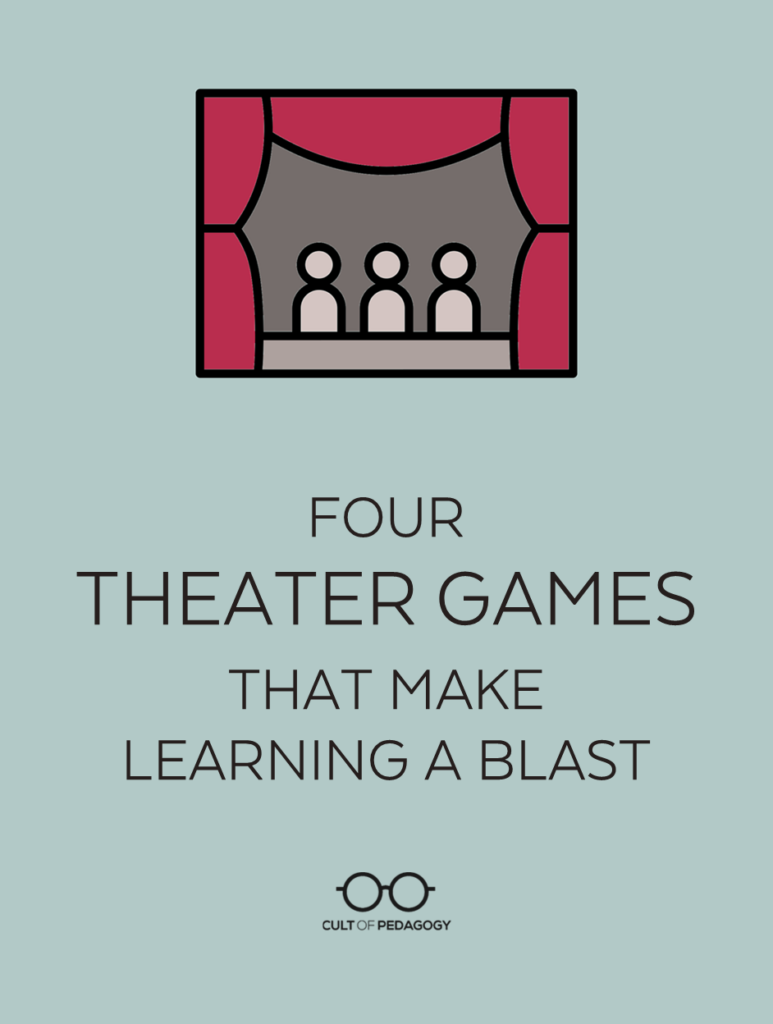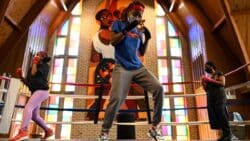
Listen to the interview with Jocelyn Greene:
Sponsored by EVERFI and The Wired Classroom
Picture this: A group of students stands in front of the class taking turns speaking confidently about the content they’ve been studying. But they’re not just kids anymore; they are news anchors, talk show hosts, or curators at an art gallery. They are playing “as if” they are inside the locations in their literature or science. This make-believe brings out their voices, their engagement, and their knowledge. Through the medium of performance, your students are getting in touch with their instincts for play, propelling their learning forward.
What I’m describing is not a fantasy. It is a reality I’ve witnessed over the last two decades as an arts educator. Drama is a proven tool to uplift learning, both academically and socially. As the founder of a theater program, Child’s Play NY, I collaborate with classroom teachers to unite theater with their curriculum. This is done mostly through games that get students interacting with content in unique and joyful ways — four of which I’m going to share here.
Benefits of Theater Across the Curriculum
Here are some research-backed ways that theater games can impact your classroom:
- Connectedness: Not only do these games reinforce academic material, they can also activate a student’s sense of belonging, making them feel seen by their peers and safe in the room, thus paving the way for higher-order learning.
- Executive Function Skills: Research shows us that this work can support executive function skills like listening, turn-taking, impulse control, and working memory.
- Kinesthetic Learning: Drama games are highly physical with exercises that compel actors to think on their feet, use their bodies to tell stories, and even retain words. In the classroom, these exercises can activate a kinesthetic learning modality, creating an element of novelty and helping students recall information.
- Social Emotional Learning: Through theater games, students exercise their theory of mind. The same exercises that help actors step into another person’s shoes can help students with perspective-taking, empathy, and reaching deeper understandings about themselves and their subjects.
- Artistry: Too often the arts are relegated to the sidelines in education, yet we know when young people have the opportunity to engage artistically, it can directly improve their cognitive, social, and emotional outcomes. With games, there is an opportunity to bring theater arts into your day — not as an elective or a club, but central to the curriculum.
What If Students Are Shy?
Students who are not self-proclaimed extroverts are often the ones who can benefit the most from this. I’ve seen students with selective mutism or other language-based learning differences play important roles in a culminating show, stunning their teacher, family, and peers in the process. The act of being another character is often very freeing and can release inhibitions.
With all of these games, there are opportunities to join in ways that will make them comfortable. Some students are reluctant to improvise, so helping them plan their text will be important. Others will want to help in a “backstage” way by DJing or setting up the playing area. However they start, encourage all your students to be very present and supportive. Inevitably, they will see how much fun it can be to jump in and play and it may become irresistible.
The Games
The following four games can be used in many subject areas to reinforce curriculum and help students deepen their understanding of the content through play. To jump directly to each game, click the links below.
Slideshow
Landmarks
Don’t Look Behind You
Magic Elevator
Game 1: Slideshow
Slideshow is a great game for students to recall and re-interpret literature, social studies, and science content. It builds their persuasive and personal writing skills as well.
The premise is simple: One person narrates a series of events that are acted out by a small group of students as if they are the slides or photos. The title of the slideshow gives a framework for the various pictures. The tableaus the students make could be a series of photographs, a PowerPoint presentation, or even a “reel” like they might make on Instagram or another social media platform. While the events can start as frozen pictures, you can expand the possibility to include short “video” clips. When the picture comes to life it can include speech, music, or even a funny filter.
How to Play
To begin, a group of students stands with their backs to the audience. The narrator announces the title of the slideshow and then describes what is in the first picture. When the narrator is finished describing the picture they say “Swipe!” as a cue for the group to turn around and instantly show what the narrator said. The narrator repeats this for three to five “slides” so that the story or event has a beginning, middle, and end.
As narrators, students are “writing on their feet,” recalling and (re)interpreting facts that they’ve learned. It is a low-stakes way to get students to demonstrate what they know and encourage their writer’s voice, vocabulary, and any other ELA fundamentals you are working on. The game works just as well for persuasive writing or personal narratives.
Before you play, brainstorm with your class how to make the pictures come to life, adding spontaneity and humor and current video sharing trends. Some of my favorites include slow motion, super-speed, backwards, adding a song, or using a funny filter like an alien or a cat.
Example: Literature
A 3rd grade class reading Roald Dahl’s book Matilda makes slideshows recounting the events of a key chapter (“When Bruce Bogtrotter Eats the Cake” or “The Demise of the Trunchbull”). Played in this way, students are working on their recall, reinforcing their understanding of the characters, locations and events of the book. Alternately, they could use the game to create a backstory for a character (“Mr. Wormwood’s Childhood” or “What Mrs. Phelps Does on Her Day Off”) or forecast what might happen in the future to a character. Here’s an example of one such title and the potential slides the narrator could say.
Title: The Future Life of Miss Honey and Matilda
Slide 1: Here you see Matilda and Miss Honey co-teaching in the 1st grade classroom! The kids are well behaved and love learning from them both. Swipe! (Two kids pretend to be Miss Honey and Matilda and the rest become the class with hands raised or folded, listening raptly.)
Slide 2: After the adoption, Miss Honey goes with Matilda on amazing vacations. She even takes her all the way to New York City! Here you can see the Statue of Liberty and the Brooklyn Bridge. Swipe! (Two students become the Brooklyn Bridge with their bodies. Another becomes the Statue of Liberty. The other two are Matilda and Miss Honey, pointing at the sights.)
Slide 3: Miss Honey throws Matilda her very first birthday party with her friends Lavender, Neville and Bruce. Actually, this is a fast-motion video, so they are singing Happy Birthday, but it might sound like the chipmunks! Swipe! (Students take their cue from the narrator, strike a celebratory pose and sing in super speed!)
Other Ideas
- ELA: A 6th grade class learning about persuasive writing could choose to make a slideshow from a variety of debatable topics. They can use this graphic organizer, with example text, to list out the ideas they will put in the slides, make sure they are using transition words, and also decide which humorous features go with each image.
- Social Studies: A 9th grade class learning about the Revolutionary War could be arguing in a “stump speech” about the cause for freedom from Britain (“Why Colonists Should Join the Revolution”). Their images could visually represent this: Slide 1: “Here’s a picture of a tea merchant in Boston who is unable to sell anything to his customers because the taxes are prohibitive.” Slide 2: “Here’s a portrait of King George III surrounded by sycophants, not really caring what happens in his colony!” Slide 3: “Here’s a picture of the Daughters of the Revolution, meeting to discuss freedom from tyranny!”
- SEL: A 1st grade class could talk about themselves (“What I Did on My Summer Vacation!” or “How I Like to Spend My Saturdays”).
- Creative Writing: A 4th grade class could make a slideshow of original stories with creative prompts they pull from a hat.
- Science: A 5th grade class learning about different environments could share about creatures and their terrain. (“Sea Turtles Life Cycle”)
Game 2: Landmarks
This game gets kids thinking creatively about places, whether they be settings in a story or a play, geographic locations, or magical worlds they create in their own writing. Research shows that by combining physical activity with words, there is greater retention, so use this to your advantage! The game is excellent for the executive function skills of working memory and impulse control and is an exceptional way to activate learning standards.
How to Play
- Pick 5 to 10 locations that tie in with what you are working on or reading.
- Have students come up with distinct gestures for each location. Encourage variety with levels (stand on a chair, or crouch into a ball), partnerships (form a bridge with two people, or make a circle with 4 others), and spatial relationships (clump together in the center of the room or spread out into the corners).
- Students move or dance around the room and when you call out a “landmark,” they recall the gesture that you’ve paired it with. Repeat this until you’ve covered all the landmarks, and then call on new volunteers to play, calling out the locations in a different order.
You can provide various roles to engage learners:
- “The Barker” – calls out the landmark.
- “The DJ” – presses play and pause on the music during the dancing.
- “The Dancers” – volunteers who are dancing on the ‘set’ and moving through poses.
- “The Audience” – participates by dancing in their seats.
Example: 4th Grade Geography
Watch this video: 4th grade NY State Geography
- Using masking tape, map the outline of New York on the floor. This has the double benefit of showing the “playing area” and also reinforces the shape of the state.
- Name eight different landmarks in the state and note where they are roughly on the map.
- Students can take turns coming up with a gesture for each landmark. (Lake Erie: Make a circle with your arms and a spooky face. Long Island: Find a friend, join hands and stretch your body wide. Catskill Mountains: Get on all fours and become a cat. Niagara Falls: Bend over your legs like a waterfall).
- Once this set-up is complete, turn on some music (like New York State of Mind) and students can dance or move how they like. The “DJ” pauses the music, and the “Barker” calls out a “landmark” from the list you brainstormed. Students quickly recall the pose you established for that location, run to the spot, and make the correct frozen gesture.
Example: 6th Grade Geometry
Students can “physicalize” math expressions. For example:
- Acute Angle: Make a little V with your body.
- Right Angle: Go to a corner.
- Isosceles: Find two other people and make a narrow triangle.
- 180 degrees: Lie on the floor in a line!
- Pentagon: Make a group of five with classmates.
Other Ideas
- Social Studies: 10th graders studying ancient civilizations become locations like the pyramids of Egypt, or the Great Wall of China.
- Science: 8th graders studying cells name different types of cells and make a pose demonstrating their function.
- SEL: 2nd graders working on a neighborhood study name the businesses on their street and create a still picture of what you might see inside.
- ELA: 7th graders reading A Midsummer Night’s Dream make landmarks of the different locations in the play.
More Tips on Playing
- You can start with a small group of students if it feels overwhelming to have the whole class up and moving. The rest of the students can make the moves from their seats.
- While you can start by calling out the locations, eventually transfer this responsibility to a student.
- Once the game has been established, play it throughout the day for brain breaks and during the group activity for Morning Meeting! This will help to build retention of information through the fun repetition of the game.
- Engage your students by having them generate the key locations and poses. Students can turn-and-talk to brainstorm locations and key details from the text, followed by a whole group share and charting of “landmarks.”
- Teachers can take photos of the poses so that everyone remembers for the next time!
Game 3: Don’t Look Behind You
This game is a joyful way to engage the whole class with an imaginative yet thoughtful connection to the curriculum.
How to Play
One person stands facing a group. They say, “Don’t look behind you, but there’s a _____.” The students all slowly turn around and “see” the imagined thing. They can either have a reaction to it, or even become it. Either way, there’s the potential for heightened dramatic play and a release of movement and sound for a few seconds. On your cue (claps, bell, or a countdown), they come back to their spots and a new volunteer takes their turn to look behind the students and say “Don’t look behind you, but there’s a ____.”
There’s inherent drama in the saying, “Don’t look behind you…” which necessitates a strong choice from the speaker. The class shares a mischievous moment as they do what they are told not to, turning behind themselves and using their imaginations to “see” the thing depicted. This can be a very giddy-making and collaborative moment for your class.
Example: 6th Grade Science
In a 6th grade science class working on geologic time, students can pick from a word wall of prehistoric animal names as they match with the era. You can have them move in sequential order through time:
- “Don’t look behind you — there’s a trilobite crawling around in the Cambrian Period.”
- “Don’t look behind you, but there’s a hungry pterosaur from the Cretacous Era who is flying by you.”
- “Don’t look behind you — there’s a saber tooth tiger in the Pleistocene Era who is stuck in a tar pit!”
Other Ideas
- ELA: 2nd graders working on world literature: “Don’t look behind you — Anansi is playing a trick and it looks like this ____!” (Note: Sub in other characters from the stories of First Nations people like Coyote, Raven or Loki. Ask students to get specific about what the trick might be based on the tale they read.)
- Science: 3rd graders working on a bird study: “Don’t look behind you! There’s a kiwi from New Guinea that’s going to screech in your ear!” (Note: Students can sub in other birds, specifying the region and giving a detail about what makes them unique.)
- ELA: 9th graders reading The Odyssey: “Don’t look behind you, but there’s a Cyclops lunging after you!” (Note: Have students recall the events of the epic poem in sequence, naming the characters that cause potential danger.)
Game 4: Magic Elevator
Magic Elevator is an extraordinary way to get students interacting with an environment, embarking on a quest, and feeling the satisfaction of “mission accomplished.” The elevator is the portal through which they can leave their classroom and journey into a world beyond. These worlds could be ancient civilizations, dystopian mathematical lands, or the forest of Arden. It takes a very simple concept that we all know — an elevator — and simply by endowing it with magical properties, it can transport the students to any environment.
How to Play
Tape out a square on the floor in the corner of your room. With a little pantomime, show where the door, buttons, and walls are in this “elevator.” A helpful mantra (from my favorite acting teacher in graduate school) is: “If you believe it, we’ll believe it.” Often, students need very little permission to tap into their imaginations and activate their child-like playfulness! So lead the way and show them, through your example, of how to believe in this make-believe structure.
Invite students into that “elevator,” with about six students at a time, depending on your space. Students push buttons to start the elevator going. The buttons can even make the sounds of the land you are going to (the sound of animals for a biomes adventure, rocket noises to propel into outer space, or even various pitched “hellos” for a community study).
The elevator moves and students love experiencing that in their body as if they were on a roller coaster. You can also have a hand in narrating the wild ride. For example, if you were to take the elevator to different planets in space — like a rocket ship — your prompting might go something like this: “Woah! The elevator is going up and down, now sideways! Wow, now we have no gravity, we are floating slowly. Oh! Looks like we have arrived and the doors are opening. Wow — here we are on Mars! Gosh is it hot. Let’s find some water if there is any!”
Right away, they set out into the land, and accomplish a clear mission on each floor before heading back to the elevator. I like to have some sort of looming threat that adds to the adventure. Depending on the curriculum and where you are taking this elevator it could be a prehistoric shark, an angry emperor, even a vengeful character like Tybalt! Once the task is complete, the students run back into the elevator. At that point, you can switch out for a new group to adventure to a new floor so as to get the whole class up and playing.
Examples
Math: Math can be incorporated every time they get in the elevator. Perhaps you need to go to the 21st floor, but the elevator only goes if you skip count by 3. Maybe you need to go to floor 32 but it only has even-numbered floors. More advanced mathematicians might have an elevator that only goes to prime numbered floors, the digits of pi, or down to negative numbers!
Science: 2nd graders doing an ocean study can use the magical elevator to go to each level of the ocean. On each floor they have to get out, find a creature that belongs to that depth and put it in their research backpack.
ELA: 10th graders reading Macbeth take the elevator to different settings in the play from the castle at Dunsinane, to the heath where the witches are, to the moving grove of Birnam Wood. In groups they can brainstorm the plot points so that when the elevator doors open, they have a certain task to do (steal the witches’ potion, march toward the castle hiding behind a tree). You can project lines from the characters as well to help them get accustomed to using the text.
Social Studies: 5th graders studying the American Revolution sneak across the room and back, as they do, name all 13 colonies correctly before the British attack!
More Tips for Playing
- Use on-theme music in the background to heighten the sense of adventure.
- Brainstorm the locations and missions beforehand, or have each group come up with their own destination and objective.
- In this game, students keep their own identity, even when exploring a new land or back in time. In this way, they don’t take on the culture of anyone else, and you won’t be imitating or accidentally caricaturing others. For example, if the elevator takes them to Ancient Egypt, and they have to sail down the Nile, they do so as themselves, kids from the 21st century!
It has been an absolute thrill to witness the impact that theater games have had in classroom after classroom. Teachers tell me that their students are more energized, that the opportunity to play creates immediate buy-in, and the topics get easily reinforced without a heavy lift from them. Just start out simply with a game that speaks to you: Your students will appreciate seeing you set an example with humor, positivity and bravery! Keep the spirit of “yes…and” as you try them, improvisationally adapting the games to fit your style and curriculum. I’m sure you — and your students — will find new twists that make them even better. I can’t wait to hear how you play!
Join our mailing list and get weekly tips, tools, and inspiration that will make your teaching more effective and fun. You’ll get access to our members-only library of free downloads, including 20 Ways to Cut Your Grading Time in Half, the e-booklet that has helped thousands of teachers save time on grading. Over 50,000 teachers have already joined—come on in.




